Items filtered by date: August 2022
Why Do My Feet Sweat Excessively?
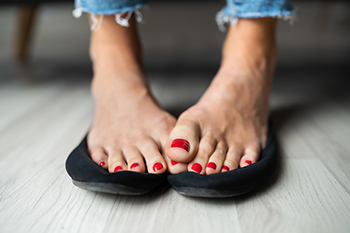
It is normal for the feet to sweat occasionally. The feet may sweat when working out, when it is hot outside, or when you are wearing shoes that are tight or made of manmade materials. However, when your feet are not under any of these conditions and they sweat, you may have a condition known as palmoplantar hyperhidrosis. Other symptoms of palmoplantar hyperhidrosis include sweating through your socks, sweating so much that you slip around in your shoes, or feet that are whitish in color and slimy. Your feet may also smell since bacteria breaking down sweat cannot evaporate producing an unpleasant odor. A chiropodist can help you manage this uncomfortable and embarrassing condition using topical medications, antiperspirants, botox injections, or other therapies that may be able to reset your sweat glands.
Plantar hyperhidrosis is a medical condition that causes excessive sweating of the feet. This problem is not only embarrassing but can also cause a variety of foot health problems if left untreated. Fortunately, there are many effective treatments available for plantar hyperhidrosis. If you have very sweaty feet, please consult with one of the chiropodists from Complete Family Footcare & Therapy. Our clinicians can help you maintain the health of your lower limbs and your mobility.
Signs & Symptoms
-
Excessive foot sweat
-
Sweating from both feet
-
Slipping out of shoes due to sweat
-
Damp footprints
-
Ruined shoes
-
Frequent foot infections
-
Friction blisters
-
Whitish foot color
-
Wrinkly, pruney feet
-
Cold feet
-
Strong odor
Treatment Options
-
Topical antiperspirants - Powders, creams, or gels that are applied directly to the feet to prevent sweating; can be over the counter or prescription strength
-
Oral medications - Pills taken by mouth to reduce sweating temporarily
-
Iontophoresis - A procedure that uses a mild electrical current conducted through water to reduce activity in hyperactive sweat glands
-
Botox - Injected into the feet to prevent activation of sweat glands
In addition to these treatment options, footwear modifications, such as wearing shoes and socks made of breathable or moisture-wicking materials, are also suggested. If you have any questions, please feel free to contact our offices located in . We offer the newest diagnostic and treatment technologies for all your foot care needs.
Tight Laces in Sport Footwear May Lead to Extensor Tendonitis
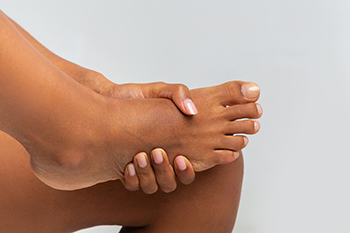
Extensor tendons are thin tendons that lie just below the surface of the skin on the top of the feet. They are instrumental in performing certain movements such as raising up the toes and flexing the feet. Because of their location in the foot and the fact that they have no padding, they are vulnerable to injury such as extensor tendonitis which is an inflammatory or degenerative condition of these tendons. Dancers, figure skaters, runners, skiers, and other athletes are more apt to develop this condition as they wear tightly laced shoes that can apply excessive pressure onto these tendons and damage them. Extensor tendonitis may be treated with a variety of methods, including medications and footwear modifications. In rare cases, a surgical procedure may be warranted. A chiropodist is a foot specialist who can diagnose the condition and determine what course of treatment would be beneficial.
Injuries to the foot and ankle are very common among athletes. If you have experienced an injury, please consult with one of the chiropodists from Complete Family Footcare & Therapy. Our clinicians will assess your condition and provide you with quality foot and ankle treatment.
Common Injuries Among Athletes:
-
Achilles tendon injuries
-
Ankle strains or sprains
-
Plantar fasciitis
-
Fractures
-
Turf toe
-
Joint dislocations
-
Sever’s disease
-
Morton’s neuroma
Symptoms
Symptoms will depend on the cause and severity of the injury. Common symptoms for a foot or ankle injury include pain, swelling, tenderness, bruising, a reduced range of motion, and difficulty bearing weight or walking on the affected foot or ankle.
Diagnosis
Sports injuries are typically diagnosed after carefully examining the affected foot or ankle. This includes moving the injured area to test its range of motion. Medical history will need to be provided, as well as detailed information about how the injury occurred. Imaging studies, such as X-rays or MRIs, may be used to confirm or rule out certain diagnoses.
Treatment
Just like symptoms, treatment will depend on the type of injury and its severity. Initial treatment for many sports injuries is aimed at controlling inflammation and promoting the healing response. The acronym R.I.C.E is a helpful guide to implement for most acute injuries. This method involves resting, icing, compressing, and elevating the affected foot or ankle. In addition, anti-inflammatory medications may be administered and orthotic devices may be prescribed. For more severe injuries, surgery may be required. Lastly, rehabilitation or physical therapy may be needed to gain full functionality in the afflicted area.
If you have any questions, please feel free to contact our offices located in . We offer the newest diagnostic and treatment technologies for all your foot care needs.
Burning Feet May Be Sounding the Alarm for an Underlying Condition
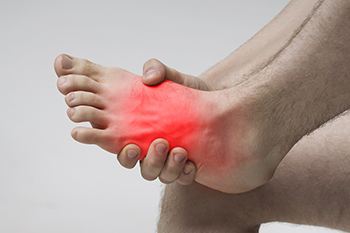
If your feet feel hot at night, the cause of this discomfort may be due to any number of underlying conditions or lifestyle factors. Those with diabetes and people who chronically abuse alcohol can suffer from peripheral neuropathy, which is a form of nerve damage in the lower extremities. Symptoms of peripheral neuropathy often include an uncomfortable burning sensation in the feet. Charcot-Marie-Tooth disease (CMT) is another medical condition that damages nerve fibers and can produce similar burning sensations, as can hypothyroidism, HIV, and vasculitis. Side effects of certain chemotherapy drugs can also damage nerves and make you feel like your feet are burning. There are less serious conditions that can cause burning feelings in your feet as well, such as menopause and pregnancy. A vitamin B-12 deficiency may also be responsible for burning feet. Anyone with burning sensations in their feet would do well to have their condition assessed by a chiropodist to discover the root of the problem and to begin appropriate treatment.
Foot pain can have many causes. To receive an accurate diagnosis and treatment for your foot pain, please consult with one of the chiropodists from Complete Family Footcare & Therapy. Our clinicians will assess your condition and provide you with quality foot and ankle treatment.
Causes
There are a variety of different conditions that can cause foot pain, including:
-
Plantar fasciitis
-
Deformities, such as bunions or hammertoes
-
Injuries to the muscles, bones, tendons, or ligaments in the feet
-
Arthritis
-
Flat feet
-
Ingrown toenails
Symptoms
The type and location of your foot pain can help determine what may be causing it and what type of treatment options are best for you.
Common types of foot pain include:
-
Heel pain
-
Arch pain
-
Toe pain
-
Ball of foot pain
-
Pain that has a stabbing, burning, or tingling quality
-
Pain that is constant, intermittent, or that gets better or worse depending on the situation
Diagnosis
A thorough medical history and physical examination of your feet will be required to determine a diagnosis. Imaging studies, such as X-rays or MRIs may be performed to rule out or confirm certain diagnoses.
Treatment
Treatment will depend on the cause of the pain. Common treatments for foot pain include resting, icing, compressing, and elevating the affected foot, wearing orthotics, or taking anti-inflammatory medications.
If you have any questions, please feel free to contact our offices located in . We offer the newest diagnostic and treatment technologies for all your foot care needs.
Simple Methods to Protect the Feet
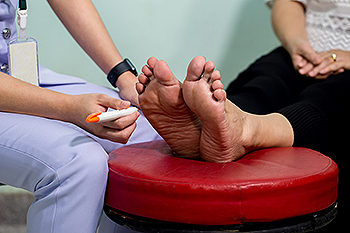
People with diabetes are often aware of the potential foot conditions that may arise. The risk may decrease when proper foot care is practiced daily, as this may help prevent dangerous foot conditions from developing. Diabetic neuropathy is common and this condition affects the feeling in the feet and legs. It can be difficult to feel existing cuts, bruises, or scrapes on the bottom of the feet, and the area can easily become infected if prompt medical attention is not attained. There are simple and effective methods that can be implemented to protect the feet. These include checking the feet daily, and it may be helpful to use a mirror to see the bottom of each foot. Additionally, it can be beneficial to wash and dry the feet thoroughly, trim the toenails correctly, and wear shoes and socks that fit correctly. It is also important to protect the feet from hot and cold temperatures, and it is advised to use sunscreen on the tops of the feet. If you would like more information about the importance of proper diabetic foot care, please consult with a chiropodist.
Diabetes can cause serious problems in the lower limbs if proper preventive measures are not taken and diabetic wound care is not performed. If you would like to learn more about caring for diabetic feet, please consult with one of the chiropodists from Complete Family Footcare & Therapy. Our clinicians can help you maintain the health of your lower limbs and your mobility.
Diabetes can lead to a host of foot and ankle complications, including:
-
Poor circulation
-
Peripheral neuropathy
-
Diabetic foot wounds and ulcers
-
Infection
-
Corns and calluses
-
Dry, cracked skin
-
Nail disorders
-
Hammertoes
-
Bunions
-
Charcot foot
If you have diabetes, you must be vigilant of any changes in your foot health. This is best done through daily foot inspections. Using a mirror to help you if necessary, look for any:
-
Cuts, scrapes, sores, or wounds
-
Bruising or discoloration
-
Swelling
-
Rash
-
Foul odor
-
Nail changes
-
Hair loss
-
Warmth and inflammation
-
Deformities
-
Lower limb pain
-
Strange sensations (numbness, tingling, burning, pins, and needles)
If you detect anything unusual, seek the care of a chiropodist as soon as possible. If you have any questions, please feel free to contact our offices located in . We offer the newest diagnostic and treatment technologies for all your foot care needs.
Are You Suffering From Nerve Damage?
How Runners Can Prevent Bunions
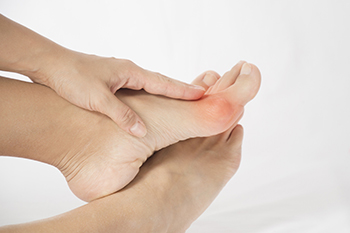
One of the most common foot conditions that can affect many people are bunions. This condition occurs near the big toe joint and causes the big toe to develop a deformity. Usually the deformity comes in the form of a bump. Runners need to be especially mindful of bunions and how to prevent them because continuing to run with bunions can exacerbate the condition and cause more problems down the road for the feet. If you are suffering from a bunion but want to continue to run, there are several steps that you can take to protect yourself. First, you can tape the affected toe before going running. Specifically, you can use non-medical pads to reduce the pressure and friction that is felt on the big toe joint while running. Additionally, you can perform certain foot exercises meant to improve the strength and mobility of your feet, which can ultimately lessen any discomfort felt in the big toe. For more information about what runners can do to lessen the pain felt from bunions or prevent bunions from forming, contact a chiropodist.
Bunions progressively worsen over time and may cause walking in your shoes to become difficult. To learn more about bunions, please consult with one of the chiropodists from Complete Family Footcare & Therapy. Our clinicians will assess your condition and provide you with quality foot and ankle treatment.
What Are Bunions?
A bunion is a bony bump that protrudes from the base of the big toe. Bunions are caused due to a misalignment of the first metatarsal. The characteristic bump of a bunion forms when the metatarsal shifts outwards from its proper position. Bunions develop slowly over time and progressively worsen without treatment. The skin over the bunion may develop calluses due to the friction from shoes. Eventually, a bunion can make walking uncomfortable or even painful. Bunions are one of the most common foot deformities and are especially common in women and older adults.
Symptoms
A bunion appears as a bulging bump on the outside of the base of the big toe.
The bunion may also:
-
Be swollen, red, or sore
-
Develop corns or calluses over it
-
Cause pain
-
Limit the big toe’s range of motion
Treatment
There are several different treatments available for bunions. Conservative treatment options include wearing shoes with a wider toe box, cushioning the bunion with a specialized pad, wearing shoe inserts, icing the bunion if it becomes inflamed, and taking medications to relieve pain. In more severe cases, more invasive procedures may be done. This may involve removing the swollen tissue around the bunion, straightening the big toe, realigning the bones at the front of the foot, or a combination of these procedures.
If you have any questions, please feel free to contact our offices located in . We offer the newest diagnostic and treatment technologies for all your foot care needs

